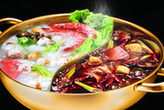The handles of ancient Tibetan seals were ornamental in terms of design and craftsmanship. Patterns and scripts engraved on the seals had a crude and vigorous style. Most of them were related to Tibetan Buddhism and Bon Religion, while the rest absorbed the quintessence of traditional geometrical patterns and decorations. As Tibetan engravers went deep into the realities of life and made close observations, they were able to explore extensive themes, use flexible skills, add ornamental elements and interest to realistic works and display a strong flavor of life.
Quaint and magnificent in style, ancient Tibetan seals boasted a kaleidoscope of artistic effects. It could be credited to the excellent skills of ancient engravers and the strength of “Zao Hua” (the Creator). Having been used for thousands of years, some ancient Tibetan seals hid their showy side at just the right level, thus displaying their mellowness, simplicity, dignity, solemnity and majesty, which could be sensed but could not be explained in words. They were not only marvelous works excelling in nature, but also models for engravers to appreciate forever.
Padauk seal with Tibetan scripts, Sanskrit and frets engraved on its surface, during the Galdan Phobrang Authority in Tibet, Qing Dynasty (1644-1911) |
Uniqueness
The art of seal-engraving in Tibetan areas was quite different from that in Mainland China. By using unique materials and elaborate craftsmanship, ancient Tibetan engravers managed to endow the seals with distinctive decorative effects. Inlaid with gold and silver, the seals blended points, lines and planes with gold and silver luster, which was natural, vivid and gorgeous.
By using unique artistic skills, engravers mostly embossed dragons, lions, peacocks and capsized lotus pedestals on the seals. With perfect workmanship, they combined gentle strength with strong force in an unsophisticated and vigorous style when engraving the seals. They also made use of Jin Yin Cuo (gold and silver inlay), an ornamental skill commonly used for making bronzes in Mainland China during early feudal dynasties.
Differing from Han seals, some Tibetan seals were gold-gilding works. Inside the cavity of Tibetan seals, there were pills, scriptures, spell books and the remains of Buddha’s bones, which possessed Jia Chi Li (Buddha’s blessing).
Cloisonné seal, with a pearl-shaped handle, silver interior and patterns of cloud and dragon, used by Tibetan eminent monks, Qing Dynasty |





Why not rent a boyfriend, or girlfriend to please parents during the Spring Festival?